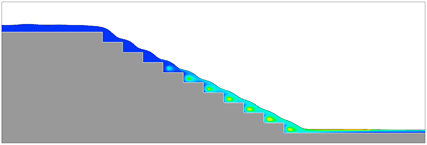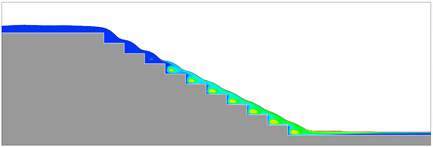
Calibrating Simulation Parameters
Goal of Calibration Study
Investigate the impact of various numerical parameters on the simulation of air entrainment on a stepped spillway.
Engineering Challenge
Generate an automated workflow that allows a user to easily study the impact of numerical parameters on the simulation of incipience of air entrainment and help calibrate them to match experimental data1.
The parameters to study are mesh size, turbulence model, turbulent length scale, and dynamic vs fixed turbulent length scale. Additionally, FLOW-3D (x) will create an image of the entrained air concentration at the last time step and an animation showing the evolution of air entrainment in the simulation.
FLOW-3D (x) Workflow
The simulation is set up with sampling volumes on steps number 3, 4, and 5 to report the amount of entrained air. FLOW-3D (x) uses nodes to construct automated workflows. The first node is used to read the simulation parameters from a .csv file. The parameters are then sent to a FLOW-3D node to execute the simulation. The post-processing node extracts the entrained air volume from sampling volumes on each step on the spillway, creates an image of entrained air at last time step, and creates an animation of air entrainment. The last node writes the reported entrained air values from our sampling volumes to a .csv file.
The budget, or number of iterations allowed, was set to 18 as there are 18 sets of parameters specified in the parameter definition input file. The runtime for a single simulation is dependent on the mesh size used in each iteration.
Parameter Study Results
Using FLOW-3D (x)’s data analysis functions and automatic image generation allow for quick visual assessments and verification of results. Additionally, air entrainment values at each step for each simulation run are easily accessed from the reported .csv file. Batch execution was used to save time on the optimization study.




